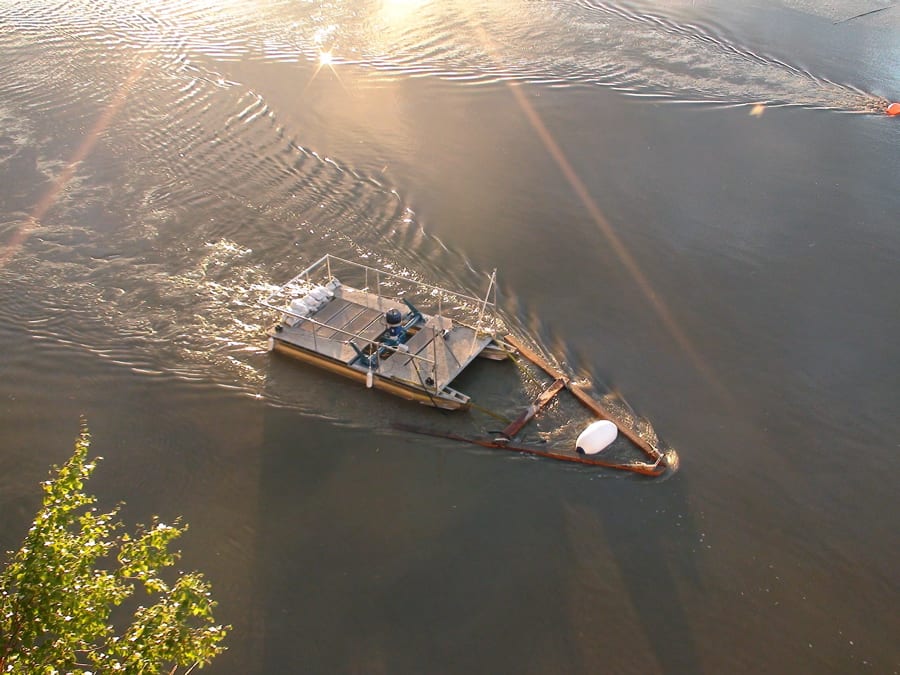The energy of moving water
Alaska has thousands of miles of coastline, providing potential for tidal and wave energy development. Alaska rivers can also be a potential resource; river in-stream and tidal energy technologies could supply some of Alaska’s energy needs.
Tidal and river in-stream energy can be extracted using hydrokinetic devices. These devices are placed directly into a river or tidal current and are powered by the kinetic energy of moving water. The available power is a function of the water current’s speed and the swept area. In contrast, traditional hydropower uses a diversion structure or a dam to supply a combination of hydraulic head and water volume to a turbine generating power. Hydrokinetic devices require a minimum current and water depth to operate. Speeds of 2-4 knots are the minimum speed required, while 5-7 knots provide for optimum operation. Ideal locations for hydrokinetic devices are those with significant flow throughout the year and that are not susceptible to serious flood events, turbulence, debris or extended periods of low water.

Tidal energy is a concentrated form of the gravitational energy exerted by the moon and, to a lesser extent, the sun.
Cook Inlet, with North America’s second-largest tidal range, has attracted interest as an energy source for the Railbelt. To quantify this, in 2013, National Oceanic and Atmospheric Administration (NOAA) partnered with the Alaska Energy Authority to create a model of Cook Inlet’s tidal energy potential. Between 2005 and 2016, state and federal funding was invested to study potential tidal power sites at Cairn Point, Fire Island and the East Foreland in Cook Inlet; Cordova; and Isanotski Strait near False Pass. ORPC is exploring the commercial viability of the False Pass resource. Someday when carbon pricing makes fossil fuels more expensive to use, investment in research and development will likely bring technological advances that will allow Alaskans to capitalize on its huge tidal energy resources.
Wave energy is the result of wind acting on the ocean surface. Alaska has one of the strongest wave resources in the world, with parts of the Aleutian Islands coast averaging more than 50 kW per meter of wave front. The challenge is lack of energy demand near the resource, the lack of commercially available generators and the high cost of pre-commercial systems. Much of Alaska’s wave energy is dissipated on remote, undeveloped shorelines. Other substantial wave energy areas include the southern side of the Alaska Peninsula and coastlines of Kodiak and Southeast Alaska.
Many rural Alaska communities situated along navigable waterways have the potential to host river in-stream hydrokinetic installations.
The University of Alaska completed a statewide assessment of in-stream hydrokinetic potential in rural Alaska in 2011, and the Alaska Center for Energy and Power (ACEP) operates a hydrokinetic test facility at Nenana on the Tanana River. Hydrokinetic systems have been tested in pilot studies in the Yukon River near Ruby and Eagle, on the Yukon River.
In 2019, FERC issued a pilot license to the Igiugig Village Council for deployment of the first commercial production unit of the RivGen Power System®, a hydrokinetic power system designed by ORPC. Given the velocity of the Kvichak River where it empties Lake Iliamna near Igiugig, the turbine is generating 35 kW. The system was commissioned in July 2019, and is the first of its kind in the United States. It is deployed year-round, and is expected to displace approximately 50 percent of the diesel the community has been burning to generate electricity on an annual basis. The village was awarded a grant for a second turbine which, combined with the first RivGen® device, smart grid technology and an energy storage system being installed in 2020, will bring Igiugig into a clean energy future where predictable river power provides for 90% of the remote community’s energy needs and becomes their baseload fuel.
While there are clearly many opportunities, significant environmental, economic and technical challenges remain for the widespread commercial deployment of wave, tidal and in-river devices. However, these technologies are evolving and are being demonstrated at more sites around the world each year.
Hydrokinetic systems have been tested in pilot studies in the Yukon River near Ruby and Eagle, on the Yukon River.